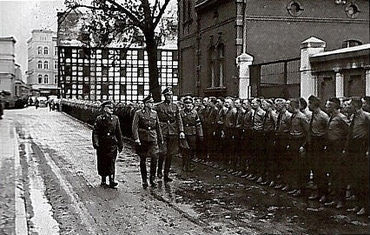
Back سيلبستشوتز Arabic Selbstschutz Spanish Selbstschutz French Selbstschutz ID Selbstschutz Italian 自衛団 Japanese ਸੇਲਬਸਚੁਟਜ਼ Punjabi Selbstschutz Polish 德裔自卫队 Chinese
| Selbstschutz | |
|---|---|
 | |
| Country | Central and Eastern Europe: Poland, Czechoslovakia, Yugoslavia and the Soviet Union |
| Allegiance | Post-WWI (in Ukraine): Imperial Germany / Russian Volunteer Army WWII: Nazi Germany/the SS |
| Type | Militia, Paramilitary police reserve or civil defense organization |
It has been suggested that this article be split into articles titled Selbstschutz (Mennonite), Selbstschutz Oberschlesien and Selbstschutz (World War II). (Discuss) (October 2023) |
Selbstschutz (German for "self-protection") is the name given to different iterations of ethnic-German self-protection units formed both after the First World War and in the lead-up to the Second World War.
The first incarnation of the Selbstschutz was a German paramilitary organisation formed after World War I for ethnic Germans who lived outside Germany in the territories occupied by Germany and Austria-Hungary following the conclusion of the Treaty of Brest-Litovsk. The purpose of these units was to protect local ethnic-German communities and, indirectly, to serve German security interests in southern Ukraine. Another iteration of the Selbstschutz concept was established in Silesia and aimed at returning Polish-inhabited territories back to Germany following the rebirth of Poland. In 1921, the units of Selbstschutz took part in the fights against the Polish Third Silesian Uprising.
The third incarnation operated in territories of Central and Eastern Europe before and after the beginning of World War II notably in Poland, the Free City of Danzig, Czechoslovakia, Yugoslavia and the Soviet Union. This Selbstschutz organization took on the character of the Nazi-era in which it was formulated and organized.
In 1938, a campaign was started by local Selbstschutz Sudetendeutsches Freikorps in the Czechoslovakian Sudetenland in order to subjugate the local Czechs prior to the Munich Conference. During the Invasion of Poland of 1939, a number of similar units conducted sabotage actions directed by the emissaries trained in Nazi Germany. These groups were officially merged into one organization, the ethnic German Volksdeutscher Selbstschutz (Self-Defense Force) of more than 100,000 men. They took part in fighting the Poles as the Fifth Column, but also served as auxiliary forces of the Gestapo, SS and SD during the early stages of the occupation of Poland, and helped the Nazi administration in the newly formed Reichsgau Danzig-West Prussia and Reichsgau Wartheland. They served as local controllers, informers, and members of execution squads particularly active in the wave of mass murders of Polish intelligentsia during Operation Tannenberg and other more local and vengeful atrocities. The killings of Poles and Jews ascribed specifically to members of Volksdeutsche Selbstschutz is estimated at the minimum of 10,000 men, women and children.[1] The force was disbanded in winter 1939/40 and the majority of its members joined the German SS or Gestapo by the spring of the following year.
- ^ Jansen and Weckbecker, 1992, pp. 7-8